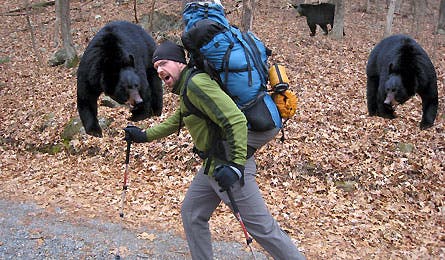Prof Hike: Where the Wild Things Are (and Aren't)

'Some of Prof. Hike's pals didn't realize this photo was faked. (J. Stevenson)'

Some of Prof. Hike’s pals didn’t realize this photo was faked. (J. Stevenson)

Most wildlife you’ll encounter will be cute, cuddly, and have fuzzy ears. (JS)
Two years ago, Prof. Hike’s wife talked to a 42-year-old man who claimed to have been attacked by two mountain lions. The man said he wounded one with a rifle shot and bloodied the second one with a knife after it pounced on him from a tree. Did this assault occur in Colorado? Nope. Montana? Not even close. It happened in Lancaster County, Pennsylvania, about 10 miles from where I live.
For several days after the attack, the local newspaper printed front-page stories about the encounter, warning that dangerous cougars could be prowling Lancaster’s Amish countryside. In fact, the victim was an Amish farmer, and according to my wife, his prodigious gray beard protected his neck and chest from scratches that covered the rest of his torso. Local wildlife experts, however, dismissed the farmer’s story, claiming that mountain lions vanished from Lancaster over a century ago. A few wild cats or escaped pets might lurk in the mountains of West Virginia and western North Carolina, they said, but not here in Pennsylvania. They concluded the perpetrators must have been bobcats, feral dogs, or a hoax. But what if you were planning a hike when you read about this attack? Would you stay home, take extra precautions, or hire this knife-wielding Amish “Rambo” to protect you?
Keep calm and carry on
The great counterweight to the lure of the outdoors is the fear of the unknown. What if it rains? What if I fall off a cliff and break my tibia? What if I get eaten by a mama grizzly?
Here’s the truth. Most hikers spend too much time and energy worrying about scary—but low-percentage—threats like bears, cougars, and poisonous snakes, and not enough time concerning themselves with dull but common dangers like germs, blisters, and hypothermia. To confirm this theory, take the following test. How many times have you been mauled by a bear or bitten by a rattlesnake? OK, now compare that figure with the number of times you’ve twisted your ankle, developed a blister, or lost part of a meal to a marauding rodent. The reason that hikers worry about the wrong things is partially the fault of this magazine. Adding the words “When Grizzlies Attack!” to the cover sells more newsstand copies, even if the average reader’s chance of having a stand-off with a bear is about the same as finding buried treasure while digging a cat-hole.
My advice isn’t to ignore macro threats like bears and rattlesnakes, but to drop them further down the fret list. Obviously, if you’re hiking in an active black bear area, take sensible precautions like making noise, bear-bagging your food, and avoiding dense berry thickets. But don’t obsess so much on bears that you break your ankle running away from what you thought was an angry grizzly but turned out to be your partner returning from the latrine. It all comes back to the most important outdoor skill anyone can practice: good ’ol common sense.
I know that ignoring the hype can be difficult and sometimes less fun. On hikes with my wife, I’m guilty of pointing to cliffs looming above the trail and saying, “Hey, that’s a great hiding place for a mountain lion.” And, a few minutes later, remarking, “Did you know that cougars can leap 20 feet and aim for the neck to sever the spinal cord?” Needless to say, my wife doesn’t appreciate my wildlife lessons. So here’s my advice. First, don’t scare your wife, husband, significant other, or kids with stories about the ninja-like stalking abilities of mountain lions. And second, prioritize your outdoor worries according to these two lists.
Pay more attention to these…
- Kill germs by washing your hands with soap or using a hand sanitizer after going to the bathroom and before eating and drinking.
- Prevent germs from spreading by pouring trail mix into your hand rather than reaching into a bag.
- Reduce insect bites by applying a DEET-based repellant at dusk, wearing long-sleeve shirts and pants, and avoiding dark-colored clothing, especially blue.
- Rodents chew through 150-denier nylon like butter—so never leave food or snacks in your tent or pack unattended.
- Keep your dog leashed or under voice control.
- Avoid injuries by being hydrated and well-fed before hiking on slippery or tricky terrain.
Pay less Attention to these…
Bears
Ranging in color from midnight black to cinnamon brown, black bears are found in all states except these 10: North Dakota, South Dakota, Iowa, Nebraska, Kansas, Illinois, Indiana, Rhode Island, Delaware, and Hawaii. The five states home to grizzly bears are Washington, Idaho, Montana, Wyoming, and of course, Alaska. Grizzlies occasionally show up in Colorado, but the last bear was killed there in 1979. And even though California’s state flag features a grizzly bear, none have been sighted in the state since 1922.
Mountain lions & cougars
You need to head west to encounter these reclusive big cats, which weigh between 100 to 200 pounds and stretch eight feet from nose to tail. Several thousand mountain lions prowl California, Oregon, Colorado, and other Rocky Mountain states. As you head east, their populations diminish. The easternmost breeding groups are found in western Texas, New Mexico, South Dakota’s Black Hills, and North Dakota’s Badlands. Young male cougars, however, range farther than females, and several have been spotted or killed in Iowa, western Oklahoma, Michigan, and even the suburbs of Chicago.
But what about Lancaster, Pennsylvania? The website for the Eastern Cougar Foundation, a big cat advocacy organization based in Harman, West Virginia, reports that cougars haven’t established east of the Mississippi yet: “Since the ECF’s inception in 1998, years of fielding, following up, and soliciting evidence from such reports have failed to produce a single cougar confirmation.” And if your naïve friends ever forward an email showing photos of a cougar on a wooden patio deck in Iowa, New York, or Pennsylvania—it’s a hoax, too.
Venomous snakes
Like cougars (and most bears), snakes aren’t interested in posing for a Facebook snapshot. All these cold-blooded (literally) reptiles desire is a sunny rock, a cozy hole in the ground, and a juicy mouse for dinner. What they don’t want is to be bothered by you. That’s why most newspaper articles about snakebites include the phrase, “The victim was bitten when he tried to pick up the snake.” Duh. Don’t harass any snake, even if you think it’s harmless. Making a close examination isn’t always smart, but the majority of venomous snakes sport a flat, triangular head, color bands, elliptical pupils, and a tail rattle. The main exception is the red-yellow-black banded coral snake, which has a blunt head and round pupils. Most harmless snakes sport solid colors and round pupils.
Deadly spiders
Arachnophobia is real, but the danger posed by spiders is often inflated. Only three spider species—brown recluse, black widow, and hobo—are dangerous to humans. Their bites are often extremely painful and cause tissue damage, but are only lethal to the very young and old. Plus, their ranges and habitats are more restrictive than most people realize. Brown recluse spiders hide out in the Midwest and South, while hobo spiders stick to the West. Black widows exist throughout the United States, but they tend to build webs in structures and wood piles. The majority of spiders hikers will spot are harmless and timid, preferring to snack on mosquitoes rather than injecting you with venom.
Next week I’ll take a break from the gloom and doom to cover 10 items of hiking and camping gear you should never own.
—Jason Stevenson